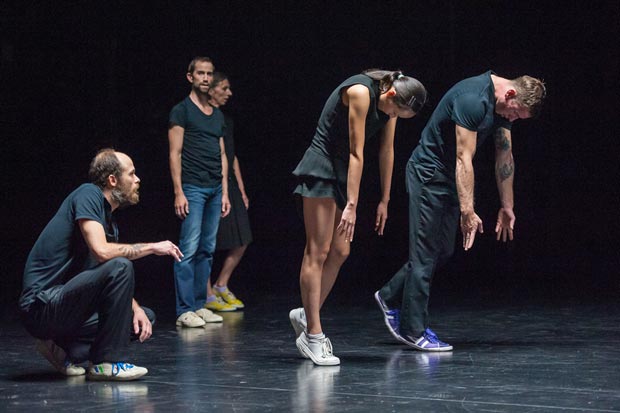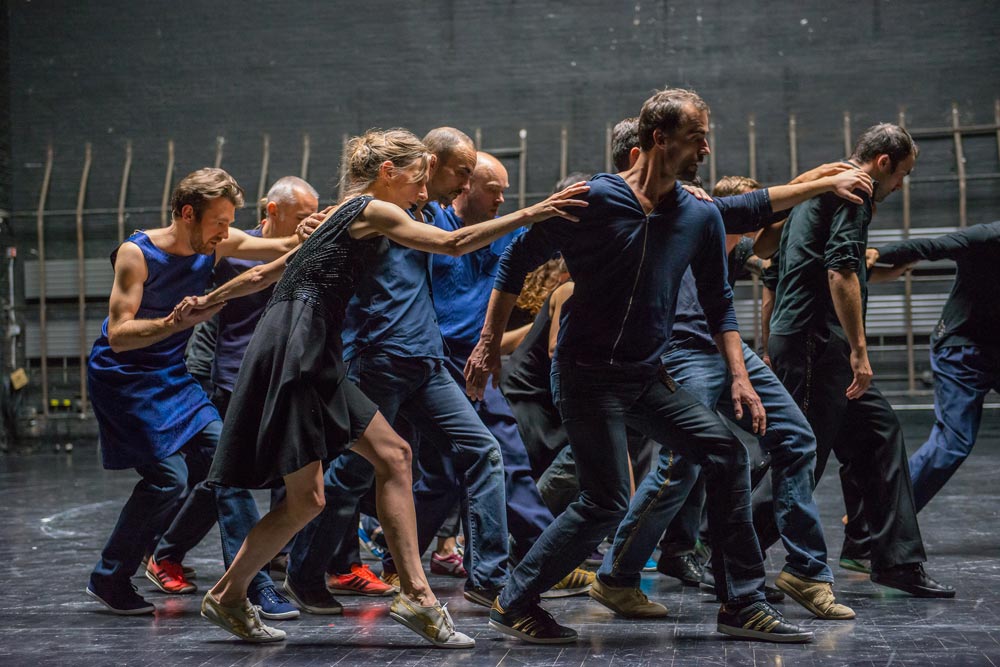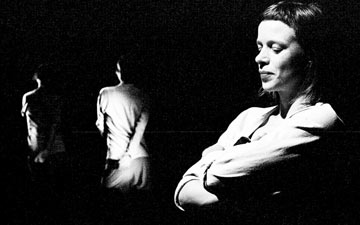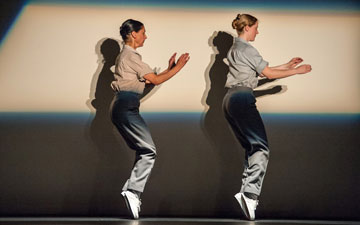
© Stephanie Berger. (Click image for larger version)
Rosas – Anne Teresa De Keersmaeker
En Atendant and Cesena
New York, Brooklyn Academy of Music
19 and 20 October 2013
www.rosas.be
www.bam.org
Singing in the Dark
There has always been something a bit monastic about Anne Teresa De Keersmaeker’s work. The restricted palette, the restrained expressions of the dancers’ faces, the plain-spokenness (and extreme precision) of the steps. Her works require stamina, attention, and self-control, not only from the dancers but also (or even more so) on the part of the audience. This weekend, during performances of her diptych En Atendant and Cesena at the Brooklyn Academy of Music, there was a steady drip of defections. It’s not hard to see why. The pacing is achingly deliberate, the lighting often painfully dim. Long stretches are performed in silence, punctuated only by the squeak of the dancers’ sneakers against the bare surface of the stage, or a cough.
And yet, for all that, the experience of watching En Atendant and Cesena was not an arid one. Instead, the two works managed to build an ascetic aura, like witnessing (or even taking part in) a kind of monastic ritual. This was particularly true of the second work, Cesena, during which the Howard Gilman Opera House was filled with the thrilling polyphonies of a fourteenth-century musical style known as ars subtilior, “the subtle art”. (En Atendant included a single voice accompanied by vielle and recorder, and used its music more sparingly.) In ars subtilior the voices interweave, creating exciting patterns that never quite settle into a single tonality. With their repetitions, feints, and rhythmic shifts, these pre-Renaissance songs seem to have no beginning, no end. And De Keersmaeker’s dance feels the same.

© Stephanie Berger. (Click image for larger version)
This is also true to of her earliest works, pieces like Fase (1982), set to the endless loops of Steve Reich. As with ars subtilior, American minimalist music emphasizes structure and subtle shifts within structure. But where Reich’s compositions can feel detached, almost clinical, these pieces are sustained by a kind of spiritual vibration. First of all, they involve the body, through the use of the voice. But in addition, these rondeaux, ballades, and motets contain texts – sung in Latin and medieval French – that tell fantastical stories, moral tales, spiritual lessons. Even without comprehending the words, one senses the existence of a detailed symbolic world.
This, in turn, imbues the dancing with meaning and tension. The vocabulary of movements used by De Keersmaeker is simple: tilts and pivots, stumbling runs, skittering glides, endless walking. Every so often, a more dynamic solo, evoking perhaps a soul in torment, a body invaded by a demonic spirit. A dancer tumbles, rolls, twitches, spins in the air, arms flickering. Death is omnipresent. Bodies are carried by the group, gently placed on the ground, alone and in piles. Near the end of the first piece, En Atendant, a man removes his clothes and lies down in the dusky half-light; he becomes Christ descended from the cross, a reminder of our own mortality, the dimple in his naked hip outlined in the darkness. One immediately thinks of the religious art contained within countless medieval and baroque cathedrals, of Caravaggio’s Entombment of Christ in Rome and Sanmartino’s Cristo Velato in Naples, of Van der Weyden’s Descent of Christ. Piles of bodes inevitably call to mind the religious massacres, endless wars, and epic plagues of the middle ages.

© Stephanie Berger. (Click image for larger version)
En Atendant and Cesena were made over the course of two years (2010 and 2011), for the Avignon Festival. In the second year, they were performed together over a single night, outdoors, in the spectacular setting of the Palais des Papes, built in the fourteenth century for the Avignon popes. En Atendant took place at the dying of the day and ended in darkness, with a naked figure pacing the empty courtyard. Cesena, named after a 1377 massacre, began in the dark and ended in the morning light. The medieval stone walls, the sky, the history of the place were imprinted in the mood of the piece. Though nothing can replace the atmospherics of such a setting, Michel François and Ann Veronica Janssens’ set design casts its own spell. The stage is bare, without even the usual Marley floor to cushion the dancers’ steps. A line (in Atendant) or circle (in Cesena) of gravel is gradually spread by the dancers’ steps. The dancers wear monastic black or dark blue. (The only spots of color, a touch of whimsy, are their sneakers.) At the back of the cavernous space, we see the grainy brick of the back wall of the theatre. Above, six panels of lights are turned on or off as the need arises. The grandeur of the unadorned structure evokes the austerity of a cathedral or a monastery. The dirt at the dancers’ feet is like the ashes of the dead. As it is spread around, it releases a subtle, musky fragrance.
En Atendant opens with a man playing a roughly-hewn ascending scale on the flute, maintaining a constant flow of sound through the technique of circular breathing. Breath is an essential element. Seemingly random patterns at times reveal themselves to be an exact mapping of the rhythmic outline of the vocal line, sung sweetly and simply by the soprano Annelies Van Gramberen. The singer sways with the internal dynamics of the songs, often acknowledging the two musicians who accompany her. (It’s curious that De Keersmaeker allows the musicians more expressive leeway than the dancers.) As she holds a note, the dancers prolong and sustain the phrase, tilting until gravity pulls them forward with the arrival of the following note. The texture of the voice is even more central to Cesena. The piece begins where Atendant ends, with a naked figure in the darkness. The dancer, a man, begins to gasp and vocalize. His keening is harrowing at first, but as he sustains it, its meaning is transformed. It becomes an expression of pure vitality.

© Stephanie Berger. (Click image for larger version)
Throughout Cesena, the singers and dancers are almost seamlessly intermixed, the vibrations of their subtly amplified voices rising together and filling the space of the theatre. Everybody sings, everybody moves, contributing to this wondrous polyphony. There are fewer passages of silence; the stage is more crowded, mostly by men. All but one of the singers (a mezzo) are men, and only two of the dancers are women. This is a curious fact: previous works by De Keersmaeker have had a decidedly feminine, almost schoolmarmish energy. Here, the performers are like a fraternal order, fulfilling a series of spiritual tasks. Even in the murk, the vibration of human voices, weaving, mingling, skipping around each other, without resolution and without end, provides sustenance. If one has the patience to sustain its meandering ways, Cesena offers a kind of jubilation.

















[…] connection between breath and singing and movement. The results are stirring, even spiritual. Here’s my review for DanceTabs. And a short […]
Just reading the titles of the two works intrigues me.
I know as much about Old French as about modern French–that is, next to nothing–so I’ll venture a remark that relies on Google Translate. “En atendant” looks to be the Old French spelling of “en attendant,” which seems to mean “meanwhile,” “in the meantime,” or “pending” as in “pending trial.” (By the way, Google Translate is flummoxed by the title of Beckett’s best-known play, En attendant Godot, which seems to be slightly ungrammatical.) I’d like to make something of that “meanwhile” in connection with the dance but can’t quite see how to do it from Marina’s descriptions.
As for Cesena, I had never heard of the place or the event for which it’s known until reading this. As a title, it sounds a bit forbidding, though proper to the music’s period. But it may be only a counterpoint to the dance itself.
Thanks for your thoughtful note. The title En Atendant seems to come from the words of one of the songs in the piece, “En Atendant, souffrir m’estuet” (a ballade). It is sung at least twice over the course of the piece. I also think it probably has to do with the feeling of waiting for night to arrive…Cesena evokes the religious massacres of the time, echoed in various images of death. At least, that’s how I interpreted it…
[…] a review of the two […]